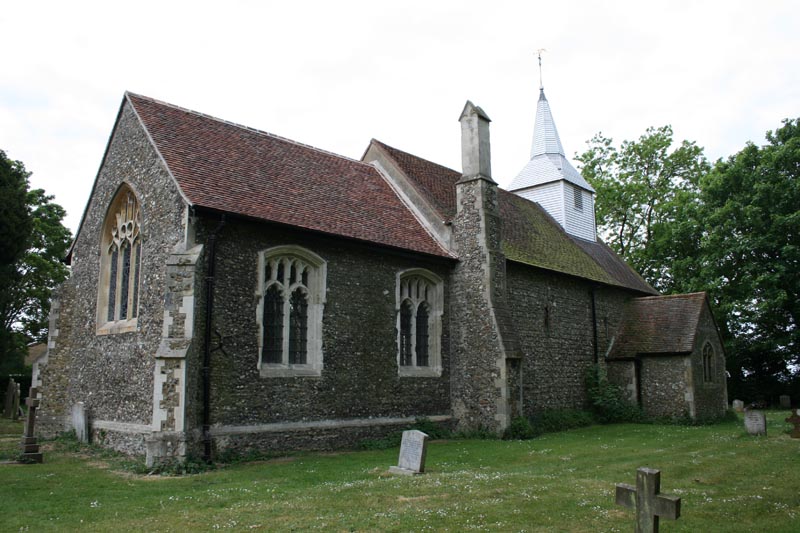The real reason is probably found in the names of the parishes: Spain & Doe. Harvey D’Espania built Spains Hall and the Church of Willingale Spain, giving his name to the parish, in the 12th Century. In the 14th Century the D’ou family came to live in Willingale. Around this time the wool industry was flourishing in Essex, and the population greatly increased. The existing church was too small to accommodate the increased number of worshippers, and rather than pull down the old church and replace it with a new one, a second church was built next to the original. The two churches are now united into one parish, the parish of Willingale. Until 1929 they were separate and quite distinct, each with its own rector.
The Parish Church, formerly that of Willingale Doe, has the main services through out the year, the other, formally the Parish Church of Willingale Spain is used occasionally for special services.

St Andrews and All Saints Church, Willingale Spain
This is the older of the two Churches, the nave being built early in the 12th Century. The Chancel and Chancel Arch were rebuilt in the 15th Century. In the 19th Century the vestry and South Porch were added. The oldest feature of the interior is a 14th century font. Within the church are some interesting memorials, including a pair of memorial brasses dated 1614, to the memory of two infant children of the rector.
The Church (St Andrew and All Saints) is a small Norman or E. Eng. structure, consisting simply of nave and chancel, with a small spire and 2 bells, one of which has a 15th cent. inscription. The corners are almost entirely built of Roman tile, as also are the sides and arch of the perfectly plain round-headed Norman N. door. The door itself has much ancient ornamental iron-work. The S. door and the W. window are also round-headed. On the N. side of the nave are two tiny narrow splayed windows, of Norman or E. Eng. work, one pointed, the other, round-headed. On the S. side is an elegant lancet window, 6ft. high by 11 inches wide, also an inserted window in the Decor. style. The chancel has 5 windows; the E. one is new, and in Perp. style; the others, 2 on each side, are all similar, being low-arched Perp. ones of the time of Henry VI. The font is octagonal. There are no brasses and few inscriptions. The Register dates from 1576. Spains Hall, ½m. S., is an ancient manor-house.
Details taken from ‘Willingale’s Two Churches’, Compiled by The Rev, Father G H Marsden
**************************************
For full information on how you can expand the Church Micro series by sadexploration please read the Place your own Church Micro page before you contact him at churchmicro@gmail.com.
See also the Church Micro Statistics and Home pages for further information about the series.
*************************************